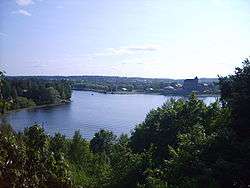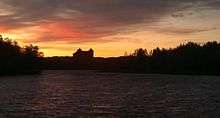Hämeenlinna
Hämeenlinna (Swedish: Tavastehus; Karelian: Hämienlinna) is a city and municipality of about 68,000 inhabitants[2] in the heart of the historical province of Tavastia (Häme) in the south of Finland. Hämeenlinna is the oldest inland city of Finland and was one of the most important Finnish cities until the 19th century. It still remains an important regional center.
Hämeenlinna Tavastehus | |
|---|---|
City | |
| Hämeenlinnan kaupunki Tavastehus stad | |
 Aerial view of the city centre of Hämeenlinna. | |
 Coat of arms | |
 Location of Hämeenlinna in Finland | |
| Coordinates: 60°59′40″N 24°28′00″E | |
| Country | |
| Region | |
| Sub-region | Hämeenlinna sub-region |
| Charter | 1639 |
| Government | |
| • City manager | Timo Kenakkala |
| Area (2018-01-01)[1] | |
| • Total | 2,031.53 km2 (784.38 sq mi) |
| • Land | 1,785.76 km2 (689.49 sq mi) |
| • Water | 245.79 km2 (94.90 sq mi) |
| Area rank | 34th largest in Finland |
| Population (2019-01-31)[2] | |
| • Total | 67,530 |
| • Rank | 14th largest in Finland |
| • Density | 37.82/km2 (98.0/sq mi) |
| Population by native language | |
| • Finnish | 97.5% (official) |
| • Swedish | 0.3% |
| • Others | 2.2% |
| Population by age | |
| • 0 to 14 | 15.8% |
| • 15 to 64 | 64.7% |
| • 65 or older | 19.5% |
| Time zone | UTC+02:00 (EET) |
| • Summer (DST) | UTC+03:00 (EEST) |
| Municipal tax rate[5] | 19% |
| Website | www.hameenlinna.fi |
Hämeenlinna is the birthplace of composer Jean Sibelius. Today, it belongs to the region of Tavastia Proper (Kanta-Häme), and before 2010 it was the residence city for the Governor of the province of Southern Finland. Nearby cities include the capital Helsinki (98 km or 61 mi), Tampere (73 km or 45 mi) and Lahti (72 km or 45 mi), which the last mentioned is the regional center of Päijänne Tavastia (Päijät-Häme).

The medieval Häme Castle (Hämeen linna) is located in the city. The municipalities of Hauho, Kalvola, Lammi, Renko and Tuulos were consolidated with Hämeenlinna on 1 January 2009.
History

There was a settlement called Vanaja by the lake Vanajavesi where the city now stands since the Viking Age. The castle was built in the late 13th century to secure Swedish power in central Finland. A village was established near Häme Castle to provide services and goods to its inhabitants.
The village was granted city rights in 1639 and soon after that the King of Sweden moved it one kilometre (0.6 miles) south to the hill on which it still stands. The city is known for its schools and academies where many famous Finns have studied. Schools, government and the military have characterised Hämeenlinna's life throughout history. Finland's first railway line opened between Hämeenlinna and Helsinki in 1862. The current Hämeenlinna railway station (Rautatieasema in Finnish) was built in 1921.
Demographics
| People with a foreign background | |
|---|---|
| County of origin | Population (2017) |
| 485 (0.72%) | |
| 484 (0.72%) | |
| 352 (0.53%) | |
| 278 (0.41%) | |
| 218 (0.33%) | |
| 208 (0.31%) | |
| 206 (0.31%) | |
| 141 (0.21%) | |
| 130 (0.19%) | |
| 106 (0.16%) | |
Notable natives or residents
- Jean Sibelius (composer)
- Eino Leino (poet)
- Juho Kusti Paasikivi (7th President of Finland)
- Turisas (metal band)
- Antony Hämäläinen (vocalist)
- Jouko Ahola (strongman/actor)
- Antti Miettinen (NHL player); won a bronze medal with Finland in the 2010 Vancouver Olympics
- Kimi Räikkönen (Formula One driver) and Jenni Dahlman (married in 2004 in Hämeenlinna)
- Juuse Saros (NHL goaltender)
Economy
Largest employers (by number of employees) [6]
- City of Hämeenlinna: 2,490
- State of Finland: 2,480
- Kanta-Häme Hospital District: 1,460
- Ruukki (Rautaruukki Oyj): 1,030
- Huhtamäki Oyj: 700
- HAMK University of Applied Sciences (an institution offering tertiary degree education): 510
- Kansanterveystyön ky: 490
- Patria Vehicles Oy: 430
- Konecranes Standard Lifting Oy: 330
- Koulutuskeskus Tavastia: 270
- Aina Group Oyj: 250
- Lindström Oy: 175
International relations

Twin towns – Sister cities
Hämeenlinna is twinned with:[7]
|
 Coat of arms at sister city Celle (Germany), granite artwork below signpost
Coat of arms at sister city Celle (Germany), granite artwork below signpost
Sport
- Elite level ice hockey teams HPK of the Liiga and HPK Kiekkonaiset of the Naisten Liiga
- Football teams FC Hämeenlinna and the men's representative team of Hämeenlinnan Härmä, which play in the third-tier Kakkonen, and the women's representative team of Hämeenlinnan Härmä of the second-tier Naisten Ykkönen
- The city hosted the modern pentathlon competition for the 1952 Summer Olympics in Helsinki.
- Hämeenlinna hosted the first round of the Underwater Rugby Euroleague in October 2012 and again in 2015.
- The Ahvenisto Race Circuit, opened in 1967, hosts many motorsport happenings. Track has Fia Grade 4 license.
References
- "Area of Finnish Municipalities 1.1.2018" (PDF). National Land Survey of Finland. Retrieved 30 January 2018.
- "Suomen virallinen tilasto (SVT): Väestön ennakkotilasto [verkkojulkaisu]. Tammikuu 2019" (in Finnish). Statistics Finland. Retrieved 15 March 2019.
- "Population according to language and the number of foreigners and land area km2 by area as of 31 December 2008". Statistics Finland's PX-Web databases. Statistics Finland. Retrieved 29 March 2009.
- "Population according to age and gender by area as of 31 December 2008". Statistics Finland's PX-Web databases. Statistics Finland. Retrieved 28 April 2009.
- "List of municipal and parish tax rates in 2011". Tax Administration of Finland. 29 November 2010. Retrieved 13 March 2011.
- "Archived copy". Archived from the original on 10 December 2006. Retrieved 13 November 2006.CS1 maint: archived copy as title (link), Taskutietoa Hämeenlinnasta, a factbook published by the city of Hämeenlinna (PDF download, in Finnish)
- "Ystävyyskaupungit" (in Finnish). City of Hämeenlinna. Retrieved 22 August 2019.
External links
| Wikimedia Commons has media related to Hämeenlinna. |

- 1952 Summer Olympics official report (pp. 60–62)
- City of Hämeenlinna – Official site
- Häme Castle

